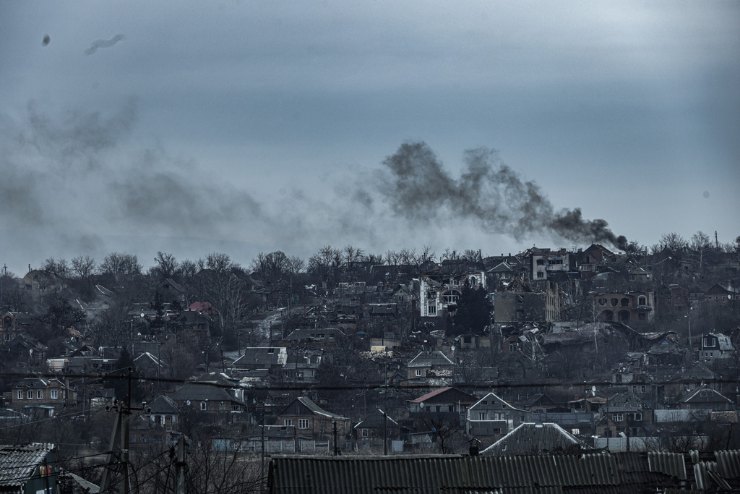The fall of Bakhmut to the Russians on May 21—after eight months of Stalingrad-like urban combat—is not a turning point in the ongoing war in Ukraine, but it is an important landmark. It could have been a minor event, both militarily and psychologically, had the Zelensky regime not decided to turn the city of 80,000 prewar inhabitants into a massively fortified symbol of its resistance. In doing so, the Ukrainian government effectively accepted the logic of the war of attrition, which suits Russia in the long run.
The number of Ukrainians killed or maimed while defending Bakhmut is not known, but it is certainly very high. If it is true that 20,000 fighters of the Wagner mercenary force have been lost in the city—as admitted by its founder and commander, Yevgeny Prigozhin—it is likely that Ukrainian losses were of the same order of magnitude, especially bearing in mind the Russians’ overwhelming superiority in artillery. According to the London-based Royal United Services Institute, Russian artillery has greatly improved its effectiveness over the past year and currently presents the greatest challenge to Ukrainian operations. Ukrainian claims that their losses were just one-fifth of those on the Russian side are at odds with Kiev’s earlier admission that its forces were losing 100 to 200 men daily in a battle that lasted well over 200 days.
The commander of the Ukrainian Armed Forces, General Valery Zaluzhny, reportedly had been trying in vain since late winter to convince President Zelensky to evacuate Bakhmut to save manpower and ordnance for a possible counteroffensive later this spring. Germany’s Bild magazine reported as early as March 6 that “while there was a great deal of unity between the two leaders at the very beginning of the war and the roles were clearly divided, this has now changed.” In the end, Zelensky rejected for reasons of personal prestige what appears to have been sound advice based on operational necessity, having declared on Feb. 3 (and repeatedly thereafter) that “Fortress Bakhmut” would not fall.
Bakhmut’s fall may have political consequences of far greater import than its military value. If, in the aftermath of this battle, it turns out that Ukraine lacks manpower and resources to stage a major counteroffensive—which its leaders and the media have been heralding for months—its Western backers (especially in Europe) will be less enthusiastic about continuing to donate tens of billions in arms and equipment. Retired British General Sir Richard Shirreff, a former deputy supreme allied commander Europe, put it bluntly in a recent interview: “It’s got to be able to demonstrate success after the support that it has been given by NATO countries and other partners.”
Ukraine’s ability to do so at this point is uncertain. Even before the fight over Bakhmut became a massive battle of attrition, Ukrainian artillery had expended ammunition more quickly than Kiev’s Western backers could replenish. Any Ukrainian offensive would therefore proceed on a logistic shoestring. Ukrainian forces use some 7,000 artillery rounds a day, while the U.S. produced 14,000 a month before the war—and it is unable to significantly increase that rate. U.S. Undersecretary of Defense for Policy Colin Kahl told Congress last February the Ukraine conflict showed that “our defense industrial base was not at the level that we needed it to be to generate munitions.” According to Raytheon’s CEO, the Ukrainians fired in the first eight months of the war the equivalent of 13 years of production of Javelin anti-tank missiles and five years’ worth of Stinger surface-to-air missiles. It stands to reason that in the 16th month of the war this volume has been at least doubled.
History teaches us that in a war of attrition Russia has an inherent advantage over any adversary. After some initial defeats it finally prevailed over Poland in the Time of Troubles (1606-1613), over Sweden in the Great Northern War (1700-1721), over Napoleon’s France in 1812, and—most spectacularly—over the Greater German Reich in 1941-1945. Trying to fight a war of attrition against Russia was a miscalculation of Zelensky and his foreign backers. The problem for the rest of the world is that, given a Washington foreign policy establishment incapable of admitting its mistakes, miscalculation will likely lead to escalation.
The danger of escalation was on full display in Kiev on May 25, when U.S. Under Secretary of State for Political Affairs told an audience via video link that Washington has been helping plan the Ukrainian counteroffensive against Russia since the beginning of this year. “We have been working on [it] with you for some four-to-five months,” she said, added that the attack will be “likely starting and moving concurrently” with the NATO summit in Lithuania, scheduled for July 11.
“Cannon thunder as accompanying music—how nice,” commented Wolfgang Koydl in the Weltwoche on May 28. “In other words, an attack on nuclear-armed Russia bears the signature of nuclear-armed America—and a senior U.S. official is openly admitting this.”
Koydl ended on a sarcastic note untypical of German-language commentators: “Is this a life-threatening escalation? But where from? As is well known, only the Russians escalate.”
The moment of truth will come if the Ukrainian counteroffensive fizzles out, and especially if the Russians respond by starting a major advance of their own. As former Pentagon advisor Col. Douglas Macgregor said earlier this week, the real risk is that “fools in Washington will talk about direct intervention.”
To paraphrase Talleyrand, that would be worse than a crime; that would be a mistake, on par with the series of tragic mistakes which were made in European capitals in July 1914.



Leave a Reply